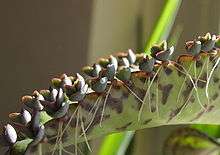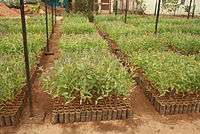Vegetative reproduction



Vegetative reproduction (vegetative propagation, vegetative multiplication, vegetative cloning) is a form of asexual reproduction in plants. It is a process by which new organisms arise without production of seeds or spores. It can occur naturally or be induced by horticulturists.
Although most plants normally reproduce sexually, many have the ability for vegetative propagation, or can be vegetatively propagated if small pieces are subjected to chemical (hormonal) treatments. This is because meristematic cells capable of cellular differentiation are present in many plant tissues. Horticulturalists are interested in understanding how meristematic cells can be induced to reproduce an entire plant.
Success rates and difficulty of propagation vary greatly. For example willow and coleus can be propagated merely by inserting a stem in water or moist soil. On the other hand, monocotyledons, unlike dicotyledons, typically lack a vascular cambium and therefore are harder to propagate.
Types
In a wide sense, methods of vegetative propagation include cutting, vegetative apomixis, layering, division, budding, grafting and tissue culture. Cutting is the most common artificial vegetative propagation method, where pieces of the "parent" plant are removed and placed in a suitable environment so that they can grow into a whole new plant, the "clone", which is genetically identical to the parent. Cutting exploits the ability of plants to grow adventitious roots (i.e. root material that can generate from a location other than the existing or primary root system, as in from a leaf or cut stem) under certain conditions. Vegetative propagation is usually considered a cloning method. However, there are several cases where vegetatively propagated plants are not genetically identical. Root cuttings of thornless blackberries will revert to thorny type because the adventitious shoot develops from a cell that is genetically thorny. Thornless blackberry is a chimera, with the epidermal layers genetically thornless but the tissue beneath it genetically thorny. Similarly, leaf cutting propagation of certain chimeral variegated plants, such as snake plant (Sansevieria trifasciata), will produce mainly nonvariegated plants. Grafting is often not a complete cloning method because seedlings are used as rootstocks. In that case only the top of the plant is clonal. In some crops, particularly apples, the rootstocks are vegetatively propagated so the entire graft can be clonal if the scion and rootstock are both clones. Apomixis (including apospory and diplospory) is a type of reproduction that does not involve fertilisation. In flowering plants, unfertilized seeds are involved, or plantlets that grow instead of flowers. Hawkweed (Hieracium), dandelion (Taraxacum), some citrus (Citrus) and many grasses such as Kentucky blue grass (Poa pratensis) all use this form of asexual reproduction. Bulbils are sometimes formed instead of the flowers of garlic.
Vegetative structures
Virtually all types of shoots and roots are capable of vegetative propagation, including stems, basal shoots, tubers, rhizomes, stolons, corms, bulbs, and buds. In a few species (such as Kalanchoë), leaves are involved in vegetative reproduction.
- The rhizome is a modified underground stem serving as an organ of vegetative reproduction, e. g. Polypodium (polypody), Iris, Couch Grass and Nettles.
- Prostrate aerial stems, called runners or stolons are important vegetative reproduction organs in some species, such as the strawberry, numerous grasses, and some ferns.
- Adventitious buds form on roots near the ground surface, on damaged stems (as on the stumps of cut trees), or on old roots. These develop into above-ground stems and leaves.
- A form of budding called suckering is the reproduction or regeneration of a plant by shoots that arise from an existing root system. Species that characteristically produce suckers include Elm (Ulmus) and members of the Rose Family (Rosa).
- Another type of a vegetative reproduction is the production of bulbs. Plants like onion (Allium cepa), hyacinth (Hyacinth), narcissus (Narcissus) and tulips (Tulipa) reproduce by forming bulbs.
- Other plants like potatoes (Solanum tuberosum) and dahlia (Dahlia) reproduce by a method similar to bulbs: they produce tubers.
- Gladioli and crocuses (Crocus) reproduce by forming a bulb-like structure called a corm.
- Some orchids reproduce by the growth of keikis from the stem or cane of the parent plant.
Natural vegetative propagation
Natural vegetative propagation is mostly a process found in herbaceous and woody perennial plants, and typically involves structural modifications of the stem, although any horizontal, underground part of a plant (whether stem, leaf, or root) can contribute to vegetative reproduction of a plant. Most plant species that survive and significantly expand by vegetative reproduction would be perennial almost by definition, since specialized organs of vegetative reproduction, like seeds of annuals, serve to survive seasonally harsh conditions. A plant that persists in a location through vegetative reproduction of individuals over a long period of time constitutes a clonal colony.
In a sense, this process is not one of reproduction but one of survival and expansion of biomass of the individual. When an individual organism increases in size via cell multiplication and remains intact, the process is called "vegetative growth". However, in vegetative reproduction, the new plants that result are new individuals in almost every respect except genetic. Of considerable interest is how this process appears to reset the aging clock.[1]
Artificial vegetative propagation


Vegetative propagation of particular cultivars that have desirable characteristics is very common practice. Reasons for preferring vegetative rather than sexual means of reproduction vary, but commonly include greater ease and speed of propagation of certain plants, such as many perennial root crops and vines. Another major attraction is that the resulting plant amounts to a clone of the parent plant and accordingly is of a more predictable quality than most seedlings. However, as can be seen in many variegated plants, this does not always apply, because many plants actually are chimeras and cuttings might reflect the attributes of only one or some of the parent cell lines. Man-made methods of vegetative reproduction are usually enhancements of natural processes, but they range from rooting cuttings to grafting and artificial propagation by laboratory tissue culture.
In horticulture, a "cutting" is a piece that has been cut off from a mother plant and then caused to grow into a whole plant. Often this involves a piece of stem that is treated with rooting liquid or powder containing hormones. In some species root cuttings can produce shoot growth. When the cutting has become a self-sufficient plant, it is genetically identical to the mother plant except when chimeric tissues or similar complications affect the outcome.
A related form of regeneration is that of grafting. A stem piece or a single bud (the scion) is joined onto the stem of a plant that has roots (the rootstock), or a stem piece can be joined to a root piece. A popular use of grafting is to produce fruit trees, sometimes with more than one variety of the same fruit species growing from the same stem. Rootstocks for fruit trees are either seedlings or propagated by layering.
Cultivated plants propagated by vegetative methods
A number of commonly cultivated plants are usually propagated by vegetative means rather than by seeds. This is a listing of such plants:
- African violets — leaf cuttings
- Apple — grafting
- Avocado — grafting
- Banana — sucker removal
- Blackberries (Rubus occidentalis) — stem cuttings
- Canna — division
- Cannabis — stem cuttings
- Citrus (lemon, orange, grapefruit, Tangerine, dayap) — grafting
- Date — sucker removal
- Fig — stem cuttings
- Garden strawberry — runners (stolons)
- Grapes — stem cuttings, grafting, aerial layering
- Hops — stem cuttings
- Jasmine - stem cuttings
- Kumquat - stem cuttings, grafting
- Manioc (cassava) — stem cuttings
- Maple — stem cuttings, grafting
- Nut crops (walnut, pecan) — grafting
- Olive — stem cuttings and layering
- Peach — grafting
- Pear — grafting
- Pineapple — stem cuttings
- Plum — stem cuttings
- Poplar — stem cuttings
- Potato — stem (tuber) cuttings
- Rose - stem cuttings
- Sansevieria - Leaf cuttings or division
- Sugar cane — stem cuttings
- Tea — stem cuttings
- Vanilla — stem cuttings
- Verbena — stem cuttings
- Willow — stem cuttings
- Bryophyllum - leaf cuttings
See also
References
- ↑ (General J. Grant (1864). "Vegetative Reproduction in New York: a comprehensive study. Stony Brook University Press: NY, NY.